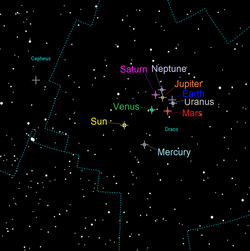Pole star project
This project is an original research project to assess the feasibility that a dwarf star much smaller than the Sun either caught up with the Sun or the Sun caught up with it while they orbited the Galaxy.
As the Earth's orbit around the Sun lies at about a 50° tilt to the plane of the Galaxy, an approaching dwarf or subdwarf star could be perceived as a pole star at some point by hominin inhabitants of Earth. As a North Pole star, it is likely that the dwarf star would only be seen and studied in the northern hemisphere.
Pole stars
[edit | edit source]

At the present time, the northern pole star, or North Star, is a moderately bright star with an apparent magnitude of 1.97 (variable), the brightest star in the Ursa Minor constellation (at the end of the or "handle" of the "Little Dipper" asterism).[1] Its current (October 2012) declination is +89°19'8" (as per epoch J2000 it was +89°15'51.2"). Therefore it always appears due north in the sky to a precision better than one degree, and the angle it makes with respect to the horizon is equal to the latitude of the observer. It is consequently known as Polaris (from Latin stella polaris "pole star"). It also retains its older name, Cynosura, from a time before it was the pole star, from its Greek name meaning "dog's tail" (as the constellation of Ursa Minor was interpreted as a dog, not a bear, in antiquity).
Due to the precession of the equinoxes (as well as the stars' proper motions), the role of North Star passes from one star to another. The name stella polaris has been given to α Ursae Minoris since at least the 16th century, even though at that time it was still several degrees away from the celestial pole. Gemma Frisius determined this distance as 3°7' in the year 1547.[2]
In the Roman era, the celestial pole was about equally distant from α Ursae Minoris (Cynosura) and β Ursae Minoris (Kochab). Before this, during the 1st millennium BC, β Ursae Minoris was the bright star closest to the celestial pole, but it was never close enough to be taken as marking the pole, and the Greek navigator Pytheas in ca. 320 BC described the celestial pole as devoid of stars. Polaris was described as αει φανης "always visible" by Stobaeus in the 5th century, when it was still removed from the celestial pole by about 8°. It was known as scip-steorra ("ship-star") in 10th-century Anglo-Saxon England, reflecting its use in navigation.
The precession of the equinoxes takes about 25,770 years to complete a cycle. Polaris' mean position (taking account of precession and proper motion) will reach a maximum declination of +89°32'23", so 1657" or 0.4603° from the celestial north pole, in February 2102. Its maximum apparent declination (taking account of nutation and aberration) will be +89°32'50.62", so 1629" or 0.4526° from the celestial north pole, on 24 March 2100.[3]
In 3000 BC the faint star Thuban in the constellation Draco was the North Star. At magnitude 3.67 (fourth magnitude) it is only one-fifth as bright as Polaris, and today it is invisible in light-polluted urban skies.
The Celestial south pole is moving toward the Southern Cross, which has pointed to the south pole for the last 2,000 years or so. As a consequence, the constellation is no longer visible from subtropical northern latitudes, as it was in the time of the ancient Greeks.
There have been many pole stars throughout the millennia. Around 2000 BC, the star Eta Hydri was the nearest bright star to the Celestial south pole. Around 2800 BC, Achernar was only 8 degrees from the south pole.
Orbital poles
[edit | edit source]
An orbital pole is either end of an imaginary line running through the center of an orbit perpendicular to the orbital plane, projected onto the celestial sphere. It is similar in concept to a celestial pole but based on the planet's orbit instead of the planet's rotation.
The north orbital pole of a celestial body is defined by the right-hand rule: If you curve the fingers of your right hand along the direction of orbital motion, with your thumb extended parallel to the orbital axis, the direction your thumb points is defined to be north.
At right is a snapshot of the planetary orbital poles.[4] The field of view is about 30°. The yellow dot in the centre is the Sun's North pole. Off to the side, the orange dot is Jupiter's orbital pole. Clustered around it are the other planets: Mercury in pale blue (closer to the Sun than to Jupiter), Venus in green, the Earth in blue, Mars in red, Saturn in violet, Uranus in grey partly underneath Earth and Neptune in lavender. Dwarf planet Pluto is the dotless cross off in Cepheus.
See also
[edit | edit source]References
[edit | edit source]- ↑ van Leeuwen, F. (2007). HIP 11767. http://webviz.u-strasbg.fr/viz-bin/VizieR-5?-out.add=.&-source=I/311/hip2&recno=11739. Retrieved 2011-03-01.
- ↑ Steelsius 1556. Gemmae Frisii de astrolabo catholico liber: quo latissime patentis instrumenti multiplex usus explicatur, & quicquid uspiam rerum mathematicarum tradi possit continetur. http://books.google.com/books?id=8XE6AAAAcAAJ&pg=PT62.
- ↑ Jean Meeus, Mathematical Astronomy Morsels Ch.50; Willmann-Bell 1997
- ↑ J. Herschel (June 1918). "The poles of planetary orbits". The Observatory 41: 255-7. http://adsabs.harvard.edu/full/1918Obs....41..255H. Retrieved 2013-07-10.
External links
[edit | edit source]{{Anthropology resources}}{{Archaeology resources}}
{{Radiation astronomy resources}}
